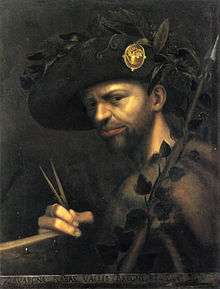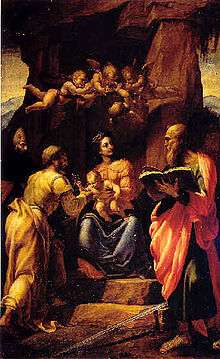Gian Paolo Lomazzo
Gian Paolo Lomazzo (26 April 1538 – 27 January 1592; his first name is sometimes also given as "Giovan" or "Giovanni") was an Italian painter, best remembered for his writings on art theory, belonging to the second generation that produced Mannerism in Italian art and architecture.
Giovanni Paolo Lomazzo | |
|---|---|
 Self-portrait | |
| Born | 26 April 1538 |
| Died | 27 January 1592 (aged 53) Milan |
| Nationality | Italian |
| Known for | Painting, Art criticism |
| Movement | Italian Renaissance |

Early life
Gian Paolo Lomazzo was born in Milan from a family emigrated from the town of Lomazzo. His early training was with Giovan Battista della Cerva in Milan. He painted a large Allegory of the Lenten Feast for San Agostino in Piacenza (1567). Other works by his hand include an elaborate dome with Glory of Angels for the Capella Foppa in San Marco in Milan, and the Fall of Simon Magus in the wall of the chapel.
He was admired as an artist and in 1562 was depicted on a medallion by Annibale Fontana which described him as having been introduced by Mercury to Fortune (commercial success).[1]
Writing on art theory and criticism
Lomazzo became blind in 1571, and turned to writing, producing two complex treatises that are milestones in the development of art criticism. His first work, Trattato dell'arte della pittura, scoltura et architettura (1584) is in part a guide to contemporary concepts of decorum, which the Renaissance inherited in part from Antiquity, which controlled a consonance between the functions of interiors and the kinds of painted and sculpted decors that would be suitable. Lomazzo offered a systematic codification of esthetics typical of the increasingly formalized and academic approaches prevalent during the later sixteenth century and has been described as a central figure in the development of Italian mannerist theories.[2]
Lomazzo's less practical and more metaphysical Idea del tempio della pittura ("The ideal temple of painting", 1590) offers a description along the lines of the "four temperaments" theory of human nature and personality, containing the explanations of the role of individuality in judgment and artistic invention.
Lomazzo's criticism took into account three aspects of art criticism: doctrina, the record of discoveries— such as perspective— that artists had made in the course of history; prattica, the personal preferences and maniera of the artist, and iconography, the literary element in arts. Lomazzo’s contribution to art criticism was his systematic extraction of abstract concepts from art, not merely a recounting of the marvels of verisimilitude and technique and anecdotes of the works' reception among contemporaries of the type that Giorgio Vasari had reported in the previous generation.
David Piper quotes[3] his influential views on portraiture:
- “Emperors above all other Kings and Princes should be endowed with majesty, and have a noble and grave air which conforms to their station in life … even though they be not so naturally in life.”
Giovanni Ambrogio Figino, Cristoforo Ciocca, and Girolamo Ciocca were his pupils.
Notes
- Pope-Hennessy, John (1966). The Portrait in the Renaissance. Princeton University Press. p. 209.
- Kemp, Martin, ed. (2000). The Oxford History of Western Art. Oxford University Press. p. 396.
- Piper, David (1992). The English Face. National Portrait Gallery. p. 33.
References
- Kemp, M.: 'Equal Excellences': Lomazzo And The Explanation of Individual Style in the Visual Arts, in Renaissance Studies vol 1.1, March 1987.
- Lomazzo, Gian Paolo: Trattato dell'arte della pittura, scoltura et architettura [Milano 1584] in Scritti sulle arti Vol. II, Roberto Paolo Ciardi, Florence 1974.
- Romano, G., Giovan paolo Lomazzo, in Gaudenzio Ferrari e la sua scuola: i cartoni cinquecenteschi dell'Accademia Albertina, Torino 1982
- J. Lynch, Giovanni Paolo Lomazzo’s self portrait in the Brera, in «Gazette des Beaux Arts», LXIV, 1964, pp. 189 ss.
- Manegold, C.: Wahrnehmung - Bild - Gedächtnis. Studien zur Rezeption der aristotelischen Gedächnistheorie in den kunsttheoretischen Schriften des Giovanni Paolo Lomazzo; Ph.D. thesis. Published as Studien zur Kunstgeschichte vol. 158; Olms 2004. ISBN 3-487-12675-3. In German.
- Lomazzo, G. P. Rabisch, edited by D. Isella, Torino 1993
- Rabisch. Il grottesco nell’arte del Cinquecento. L’Accademia della Val di Blenio, Lomazzo e l’ambiente milanese, edited by M. Kahn-Rossi and F. Porzio, Milano 1998
- Isella, D., Lombardia stravagante, Torino 2005
External links
![]()
- Vita of Gian Paolo Lomazzo.
- Brief description (in Italian).
- Another description, (in Italian).
- Lomazzo, Christ in the Garden of Gethsemane (Biblioteca Ambrosiana) An exercise in dramatic lighting of a nocturnal subject. (description in Italian).
- Gian Paolo Lomazzo, "The composition of grotesques", Chapter 48 of the sixth book of Treatise on Painting, Sculpture, and Architecture (Trattato dell'arte della pittura, scoltura, et architettura). Milan, 1585.
- Leonardo da Vinci, Master Draftsman, an exhibition catalog from The Metropolitan Museum of Art (fully available online as PDF), which contains material on Lomazzo (see index)
- Painters of reality: the legacy of Leonardo and Caravaggio in Lombardy, an exhibition catalog from The Metropolitan Museum of Art (fully available online as PDF), which contains material on Lomazzo (see index)